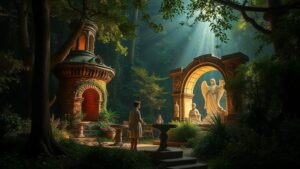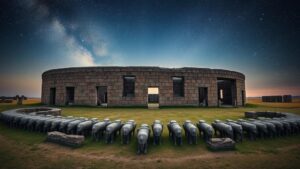Delving into the mysteries of ancient cliffside cities like those rumored in the Grand Canyon.
Delving into the Mysteries of Ancient Cliffside Cities
The allure of ancient cliffside cities has captivated historians, archaeologists, and adventurers alike. While many ruins are scattered across the globe, there are intriguing rumors of ancient cities hidden in the rugged landscapes of the Grand Canyon. These stories, steeped in myth and speculation, prompt a closer examination into what ancient civilizations may have thrived in this dramatic environment.
A Brief Overview of the Grand Canyon
The Grand Canyon, located in northern Arizona, spans approximately 277 miles in length, reaching depths of over a mile. With its layered bands of red rock and the Colorado River carving through it, the canyon presents not only breathtaking views but also a geological history that dates back nearly two billion years. The canyons vastness fosters the belief that it may hold undiscovered relics from ancient cultures.
Historical Context
Evidence suggests that various Indigenous tribes, such as the Havasupai and Hopi, have lived in and around the Grand Canyon for thousands of years. Archaeological findings indicate that these communities constructed dwellings, communal sites, and even extensive irrigation systems.
- The Ancestral Puebloans (also known as the Anasazi), who inhabited the southwestern U.S. from approximately 100 AD to 1300 AD, are notable for their cliff dwellings, which can be found in other regions like Mesa Verde.
- The Sinagua culture, active in the area around 600 to 1400 AD, developed significant structures in what is now known as the northern Arizona region, indicating sophisticated urban planning.
Rumors of Cliffside Cities
The Grand Canyon is shrouded in lore, including tales of hidden cities filled with gold and riches. Most notably, in 1909, explorer Kincaid reported discovering ruins he claimed were of an ancient civilization deep within the canyon. His accounts, published in a reputable newspaper of the time, described a temple-like structure adorned with hieroglyphics and artifacts that seemed to draw from Old World influences.
Despite the excitement surrounding Kincaids discovery, the archaeological community largely dismissed it due to a lack of empirical evidence. Curiously, the U.S. Geological Survey has not found substantiated evidence of such clandestine ancient cities, but the stories persist, fueling further intrigue and investigation.
Scientific Investigations
Scientific efforts to explore the possible existence of ancient sites within the Grand Canyon have had mixed results. Archaeologists utilize advanced geophysical techniques, including ground-penetrating radar and aerial LiDAR, to identify hidden structures beneath layers of sediment and vegetation.
- In recent years, studies conducted by teams such as the Grand Canyon Archaeological Project (GCAP) uncovered ancient pottery shards and stone tools, indicating small-scale habitation.
- Also, drone technology has provided new perspectives on remote cliff faces, revealing potential locations for further excavation.
Myth vs. Reality
The mysteries surrounding the Grand Canyons ancient cliffside cities highlight an ongoing narrative where myth and reality intertwine. While credible archaeological evidence for grand lost cities remains elusive, the canyons significance as a cultural and historical hub cannot be overstated.
Researchers advocate for a balanced approach that respects indigenous narratives and cultural heritage while employing modern archaeology to uncover the truth. This includes collaboration with Native American tribes, ensuring their voices and historical significance are acknowledged in ongoing studies.
Actionable Takeaways
For those intrigued by the stories of ancient cliff dwellings in the Grand Canyon, consider the following:
- Visit the Grand Canyon to experience firsthand the striking landscapes and historical context there.
- Engage with local Native American tribes to gain a deeper understanding of their history and connection to the land.
- Stay informed about ongoing research and discoveries through platforms like the National Park Service and reputable archaeological journals.
Conclusion
The Grand Canyon remains a palimpsest of mystery, history, and ongoing discovery. Although concrete evidence of ancient cliffside cities may not yet have been found, the combination of breathtaking natural beauty and rich cultural narratives ensures that the fascination with this geological wonder will endure. As we continue to explore the depths of the canyon, both literally and metaphorically, we may yet unravel the secrets whispered by its stone walls.



